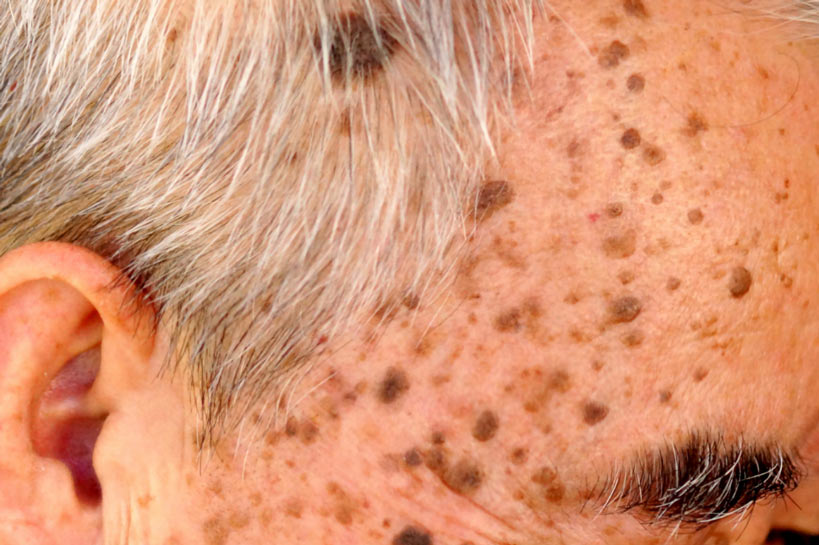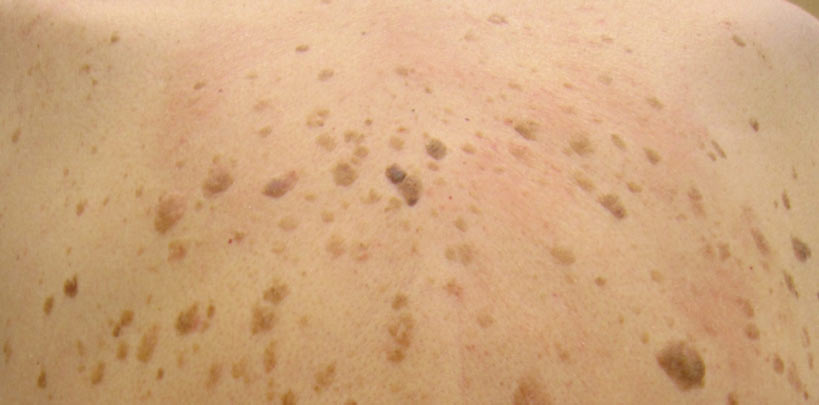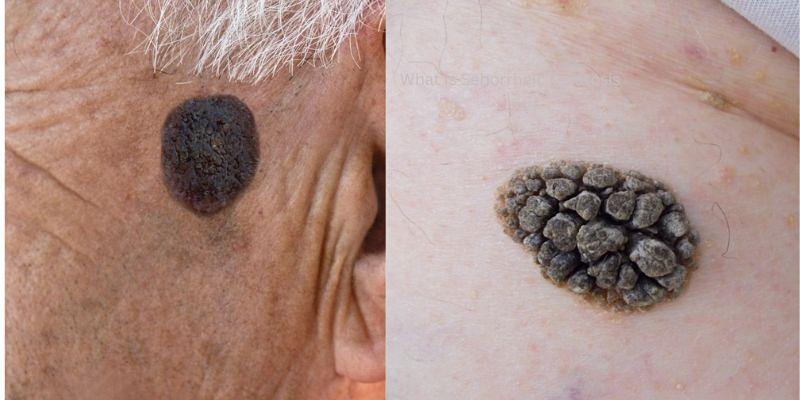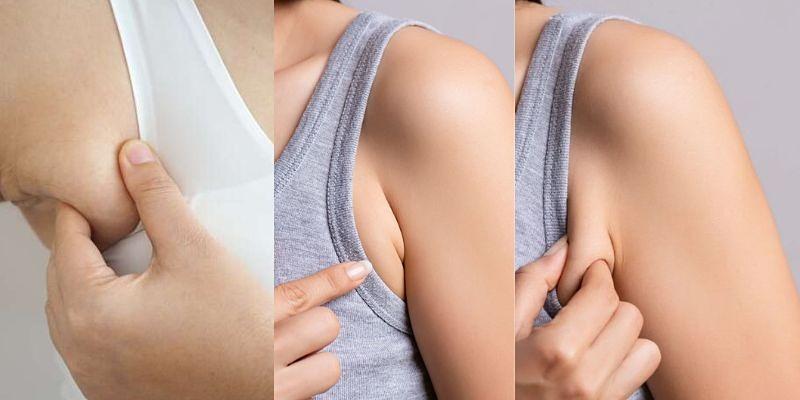You may have seborrheic keratosis if you've ever developed strange, waxy dark patches on your skin. While it's a more common affliction among older generations – with most cases appearing over 40 – even young adults can be prone to developing this condition.
Specifically, Seborrheic Keratosis (or SK) appears as small to large lesions that vary in color and look like they were stuck onto the skin. In this blog post, we'll discuss what exactly Seborrheic Keratosis is and provide tips on resolving it based on its severity. To get started, let's break down exactly what this is and why it occurs.
What is seborrheic keratosis?

Seborrheic keratosis (SK) is a common, benign skin condition characterized by small, rough bumps on the face and body. These lesions are usually tan to dark brown and can range in size from a few millimeters to several centimeters. They are irregular and may be flat or raised, smooth or scaly.
SKs typically appear on the chest, back, face, head, and neck but can also be found on other body areas. SKs are not contagious or cancerous and do not cause pain or discomfort. They commonly develop with age and often appear in clusters that may increase in size over time.
Treatment is generally unnecessary unless the lesions become irritated or itchy. However, there are some medical options available. Treatment may include freezing the lesion with liquid nitrogen or topical medications.
What does seborrheic keratosis look like?
Seborrheic keratosis is a common noncancerous skin growth. It typically appears as a raised, bumpy, tan, brown, or black growth on the skin. The size of these growths can range from very small to several inches across. Seborrheic keratosis can appear anywhere on the body but is most commonly found on the face, chest, back, and shoulders. They usually have a waxy or scaly surface. Despite their different appearances, seborrheic keratosis is usually harmless and does not require treatment. However, if the growths become irritated or unsightly, a doctor may recommend removing them.
What triggers seborrheic keratosis?

The exact cause of seborrheic keratosis is unknown, but some factors are thought to trigger its development. These include genetics, aging, exposure to ultraviolet (UV) light, and certain medical conditions. The condition tends to become more common with age as people's skin becomes thinner and they receive more UV exposure over time.
Who gets seborrheic keratosis?
Seborrheic keratosis is an extremely common skin condition that affects people of all ages and backgrounds. Though it can affect anyone, it is most commonly found in adults aged 40 or older. It is estimated that up to one-third of the population may be affected by seborrheic keratosis.
Do seborrheic keratoses cause symptoms?
No, seborrheic keratoses generally cause no symptoms. They're usually benign (noncancerous) and harmless, so most people don't need treatment.
However, if a seborrheic keratosis is bothersome or you're worried about it for any reason, talk to your doctor.
It's important to note that seborrheic keratoses can be confused with other skin conditions, and it is best to have it examined by a doctor to ensure you get an accurate diagnosis. Your doctor may want to perform a biopsy or other tests if they are concerned about malignancy (cancerous growth).
Seborrheic keratoses are a common skin condition affecting people of all ages and races. They usually appear as small, raised bumps on the skin and range in color from light to dark brown. In some cases, they may be scaly or waxy in texture. While they are mostly harmless, it's important to have your skin checked regularly by a doctor for any changes.
How do you tell seborrheic keratosis from actinic keratosis?
Seborrheic keratosis (SK) and actinic keratosis (AK) are skin lesions that may look very similar. However, some key differences distinguish the two.
Seborrheic keratosis is a non-cancerous growth on the skin, which typically presents as a raised, slightly scaly patch that is usually dark brown or black. SK lesions can range from just a few millimeters to several centimeters across. They can be smooth, waxy, or velvety in texture and are often found on the chest and face.
On the other hand, actinic keratosis is caused by long-term ultraviolet (UV) exposure from the sun. AK lesions are usually rough and scaly, ranging in size from a few millimeters to several centimeters across. The color of AK lesions can vary but is typically light pink or red. If left untreated, AK lesions can develop into a type of skin cancer called squamous cell carcinoma.
How is seborrheic keratosis treated?
The size, location, and medical history of the affected person typically determine the treatment of seborrheic keratosis. Most treatments involve some surgical intervention, such as freezing (cryotherapy), scraping (curettage), and burning (electrocautery).
Other treatments may include topical medications or laser therapy. In most cases, treatment can relieve the symptoms associated with seborrheic keratosis. However, it is important to remember that seborrheic keratosis may recur, and there is no guarantee that it will not return.
Sometimes, the condition can be treated with a combination of treatments to achieve the best possible outcome. It is important to consult your doctor to determine the best treatment for your situation.
What causes seborrheic keratosis?
The exact cause of seborrheic keratosis is unknown. It is most common in middle-aged and older adults but can occur at any age. It is more likely to affect people with fair skin. Seborrheic keratosis appears to be related to sun exposure, as the growths are often found on areas of the body that receive regular sun exposure.
FAQs
What does a seborrheic keratosis look like?
Seborrheic keratosis is a harmless skin growth that may appear white, tan, brown, or black. It looks like a wart and is typically raised and attached to the skin.
Should I worry about seborrheic keratosis?
If your doctor identifies skin growth as seborrheic keratosis, there is typically no need to be concerned. However, if the growth is growing rapidly, has a peculiar appearance, or is bleeding or painful, it is recommended that you see a doctor. You may be referred to a dermatologist.
Does seborrheic keratosis become cancerous?
Seborrheic keratoses are not cancerous and do not increase your risk of developing skin cancer or other skin conditions, even after a long period. They are also non-contagious. Although they may cause itching, they are generally not painful.
Conclusion
In Conclusion, Seborrheic Keratosis is a common skin condition that affects people of all ages and races. These growths are benign and typically don't require any treatment. However, those who find them distressing or want to reduce their appearance can be safely removed with help from a qualified dermatologist.
It's important to have any new skin growth or changes on the body checked out by a medical professional to rule out any potentially serious skin conditions. Do not attempt to remove any growths yourself.




